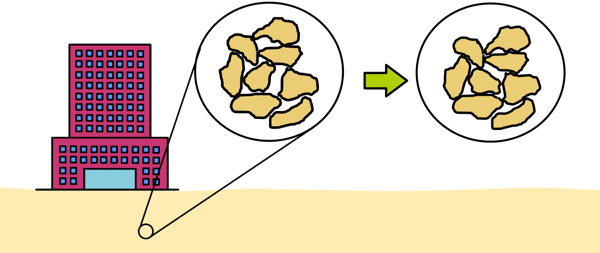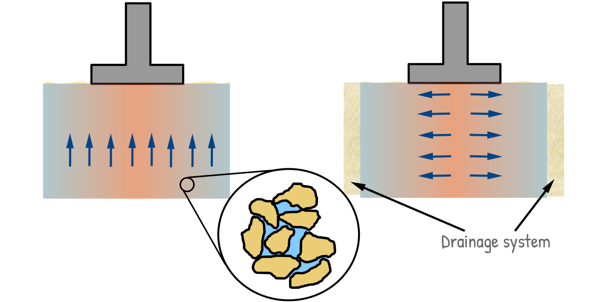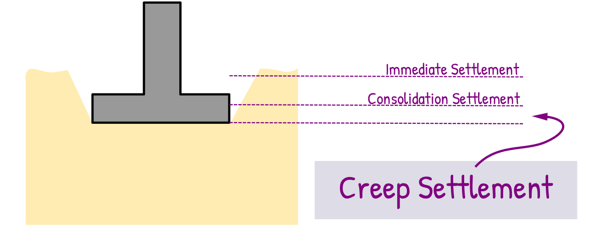When we press down on a soft pillow that we use to rest our head on, it compresses and goes down a bit. Similarly, when heavy buildings or structures are built on the ground, they can make the ground compress or sink down a little over time due to their weight. This sinking down or compression of soil, caused by factors like the weight of our building, is known as settlement of soil.

Technically, Soil settlement refers to the downward movement of soil due to changes in stresses acting on it. When a load is applied to the soil, the soil particles compress and rearrange, causing a decrease in the volume of void spaces within the soil. This compression leads to settlement, which can occur immediately after construction or gradually over time.
Settlement in the soil may be the result of both natural and deliberate human activities. Natural activities that may contribute to the settlement of the soil includes

While human induced settlement may include activities such as

Settlement can cause major problems for structures like cracking, distortion, differential settlement etc which significantly affects their performance and can even lead to structural damage.
Therefore, Engineers and builders have to consider settlement when constructing these structures, and they take measures to make sure the buildings are safe and don’t get damaged by settlement.
As geotechnical engineers, we play a crucial role in ensuring the stability of structures by calculating the amount of settlement the soil will experience under their weight.
Total settlement of the soil has primarily three components.
- Immediate Settlement
- Consolidation Settlement
- Creep Settlement
The Total Settlement of soil is the sum of all three factors

let’s briefly discuss one by one.
Immediate Settlement:
Immediate settlement is the rapid compression or settlement of soil that happens almost instantaneously right after the application of a load or the construction of a structure on it. It’s the most instant response of the soil to the new stress conditions.
When a structure or load is placed on the ground soil particles undergo some movement and re-positioning to distribute and accommodate the applied stress. They rearrange themselves and pack themselves closer reducing the air or water-filled voids between them. Which leads to the decrease in soil volume.

This rearrangement takes place very quickly, usually within seconds to minutes after the load is applied, hence the term “immediate.”
Immediate settlement sometimes referred to as elastic settlement but that is not entirely accurate.
Soil particles are not rigid; they can be compressed or displaced when subjected to external forces. When a structure or load is placed on the ground, the soil underneath undergoes compression due to the weight of the structure. This compression causes the soil particles to compress and deform elastically.
This Elastic Deformation of soil particles is temporary change in their shape or volume due to stress (load) applied to them and once the stress is removed soil particles regain their original shape and size.
But in reality once the stress is removed, some soil particles may regain their original shape and size, but there might be a small amount of permanent settlement.
It should be noted that immediate settlement can occur in both saturated and partially saturated soils. In saturated soils, it’s mainly due to particle rearrangement and in partially saturated soils, it involves both particle rearrangement and air expulsion from larger voids.
Dense and coarse-grained soils like sand experience less immediate settlement compared to loose and fine-grained soils like clay. Clay particles are more susceptible to rearrangement under pressure. Also greater the load applied, the more significant is the immediate settlement, as there’s more force pushing the particles together.

Then there is next component of the settlement
Consolidation Settlement:
When soil, particularly if it is saturated, is subjected to a load, some reduction in its volume occurs immediately due to air expulsion and particle rearrangement which is Immediate Settlement. However, this volume reduction can continue even after immediate settlement is complete. It occurs mainly because of the gradual expulsion of water from the soil voids and the rearrangement of soil particles.

When a load is applied to the saturated soil, the pressure increase is initially taken up primarily by pore water, creating excess pore water pressure. This occurs because of the inability of water to escape quickly from the compressed soil pores. This excess pressure develops a hydraulic gradient, which over time dissipates as water gradually drains out of the soil pores through lateral flow to drainage systems, or upward flow to the ground surface. As water is pushed out from the soil pores, the soil particles rearrange and come closer resulting in further settlement which is called consolidation settlement.

This is also called Primary Consolidation.
It should be noted that this process only occurs in saturated soil and involves the expulsion of water from voids over time.
As the rate of flow of water in the soil depends upon the permeability of the soil, consolidation settlement is a slow process of soil compression and settlement that occurs over an extended period after the application of a load. It can take weeks, months, or even years to complete depending on factors such as the soil’s compressibility, the magnitude of the load, and the rate of drainage.
This compression continues till equilibrium is reached when there’s no more excess pore water pressure to dissipate. At this point, the entire applied load is supported by the soil particles.
Fine-grained soils, like clay, experience slow consolidation because water has difficulty flowing through tiny Poorly connected pores. Conversely, coarse-grained soils, such as sand or gravel, consolidate much faster due to their high permeability, which allows water to escape easily.
Also thicker the soil layer slower will be the rate of settlement due to consolidation as water has to travel longer distance through the pores.
Consolidation settlement can significantly impact structures built on soil. Understanding the magnitude and rate of consolidation settlement is crucial for designing foundations that can withstand the long-term movement of the soil.
Then there is another component of the settlement
Creep Settlement:
Some soils continue to reduce their volume for a long time even after the excess pore water pressure has been dissipated and consolidation settlement is complete. This additional reduction in the volume is called Creep Settlement and is sometimes also called Secondary Consolidation.

It’s a very gradual settlement of soil that occurs over a very long period, even years or decades, under a constant load.
Creep settlement is the slowest and least understood of the three main types of soil settlement. The causes for Creep Settlement are not fully established and the exact mechanism behind creep settlement is still being researched. Unlike consolidation settlement where water plays a primary role, creep settlement happens even after the water has been squeezed out. It’s believed to be related to the ongoing process of soil particles shifting and finding new equilibrium positions under constant load.
Also Under sustained pressure, the individual soil particles themselves may undergo plastic deformation, meaning they slowly deform and change shape permanently. This can lead to even denser packing of particles and contribute to creep settlement.
Creep settlement becomes a critical factor for certain soil types, particularly organic soils like peat. In most inorganic soils, creep settlement is less significant compared to organic soils. However, fine-grained clayey soils are more prone to creep settlement compared to coarse-grained sands. This is because clay particles are more susceptible to plastic deformation and rearrangement under constant stress, leading to ongoing settlement over time.
Also Higher loads will generally lead to more creep settlement as the pressure on the soil particles is greater. In addition to that creep settlement is a time-dependent phenomenon so longer the soil is under constant load, more creep settlement will occur.

Accurately predicting the magnitude and rate of creep settlement is challenging due to the complex mechanisms involved. Geotechnical engineers rely on hteir experience, soil testing data and empirical models to make such estimations.
While creep settlement happens slowly, it can have significant consequences for structures built on soil. Over decades, excessive creep can lead to foundation failure, cracking in walls, and misalignment of structural components. Geotechnical engineers have to consider the creep settlement when designing foundations for long-term projects like dams, bridges, and high-rise buildings.
Primary consolidation or Consolidation Settlement is the most important component of total settlement. It contributes the most significant portion of the total settlement. This is especially true for fine-grained, saturated soils like clays, where excess pore water expulsion plays a major role. So we are going to study it in more detail in our coming posts.
I would like to mention here that various articles, texts and books offer different explanation to all these factors but this post presents a comprehensive view based on my research, aiming to provide a clear and well-supported understanding.






